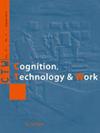主动手外骨骼对工业装配握把前臂肌肉活动的影响。
IF 3.4
3区 工程技术
Q2 ENGINEERING, INDUSTRIAL
引用次数: 2
摘要
Bioservo Ironhand®是一种市售的主动手外骨骼,用于减少抓取引起的压力。目的:本研究旨在量化Ironhand®外骨骼对前臂屈伸肌肌电活动在三个相关组合握力任务中的影响:2指握力(2Finger)、5指握力(5Finger)和全握力(FullGrip)。方法22名被试在三种不同的外骨骼条件下进行每个抓握任务(总体3×3×10 = 90次随机重复):外骨骼关闭(off),外骨骼打开,“锁定倾向”0% (On_LT0),外骨骼打开,“锁定倾向”85% (On_LT85)。在参与者最大握力的25%时,使用两个EMG传感器在指浅屈肌(M.FDS)和一个EMG传感器在指浅伸肌(M.ED)测量肌肉活动。结果铁手®外骨骼的效果因握力任务和参与者的性别而异。在全握力条件下,只有男性受试者的M.FDS肌肉活动有统计学上显著的减少。在其他握力任务(2指,5指)中,mfds的肌肉活动没有减少。对于2指状态下的雌性,On_LT0的M.FDS平均肌肉活动甚至比Off显著增加。除了握力任务和性别之间的差异,目前的研究还揭示了实质性的个体差异。结论除了统计显著性检验外,还应在受试者水平上对外骨骼效应进行详细的探索性分析,从安全性和监管角度对其进行评估。本文章由计算机程序翻译,如有差异,请以英文原文为准。
Effects of an active hand exoskeleton on forearm muscle activity in industrial assembly grips.
BACKGROUND
The Bioservo Ironhand ® is a commercially available active hand exoskeleton for reducing grip-induced stress.
OBJECTIVES
The study aimed at quantifying the effect of the Ironhand ® exoskeleton on the myoelectric muscle activity of forearm flexor and extensor muscles in three relevant assembly grip tasks: 2-Finger-grip (2Finger), 5-Finger-grip (5Finger) and Full grip (FullGrip).
METHODS
Twenty-two subjects were tested in three different exoskeleton conditions for each grip task (overall 3×3×10 = 90 repetitions in randomized order): Exoskeleton off (Off), Exoskeleton on, "locking tendency" 0% (On_LT0), and Exoskeleton on, "locking tendency" 85% (On_LT85). Muscle activity was measured at 25% of the participant's maximum grip force using two EMG sensors at the M. flexor digitorum superficialis (M.FDS) and one at the M. extensor digitorum (M.ED).
RESULTS
The effect of the Ironhand ® exoskeleton varied depending on the grip task and the participant's sex. A statistically significant reduction in muscle activity of the M.FDS was found only for male subjects in the FullGrip condition. No reduction of muscular activity in the M.FDS was found for the other grip tasks (2Finger, 5Finger). For the females in the 2Finger condition, mean muscle activity of M.FDS even increased significantly in On_LT0 compared to Off. Besides differences between grip tasks and sex, the current study revealed substantial individual differences.
CONCLUSIONS
In addition to testing for statistical significance, a detailed exploratory analysis of exoskeleton effects at subject level should be performed to evaluate these from a safety and regulatory perspective.
求助全文
通过发布文献求助,成功后即可免费获取论文全文。
去求助
来源期刊

Cognition Technology & Work
ENGINEERING, INDUSTRIAL-
CiteScore
6.90
自引率
7.70%
发文量
26
审稿时长
>12 weeks
期刊介绍:
Cognition, Technology & Work focuses on the practical issues of human interaction with technology within the context of work and, in particular, how human cognition affects, and is affected by, work and working conditions.
The aim is to publish research that normally resides on the borderline between people, technology, and organisations. Including how people use information technology, how experience and expertise develop through work, and how incidents and accidents are due to the interaction between individual, technical and organisational factors.
The target is thus the study of people at work from a cognitive systems engineering and socio-technical systems perspective.
The most relevant working contexts of interest to CTW are those where the impact of modern technologies on people at work is particularly important for the users involved as well as for the effects on the environment and plants. Modern society has come to depend on the safe and efficient functioning of a multitude of technological systems as diverse as industrial production, transportation, communication, supply of energy, information and materials, health and finance.
 求助内容:
求助内容: 应助结果提醒方式:
应助结果提醒方式:


